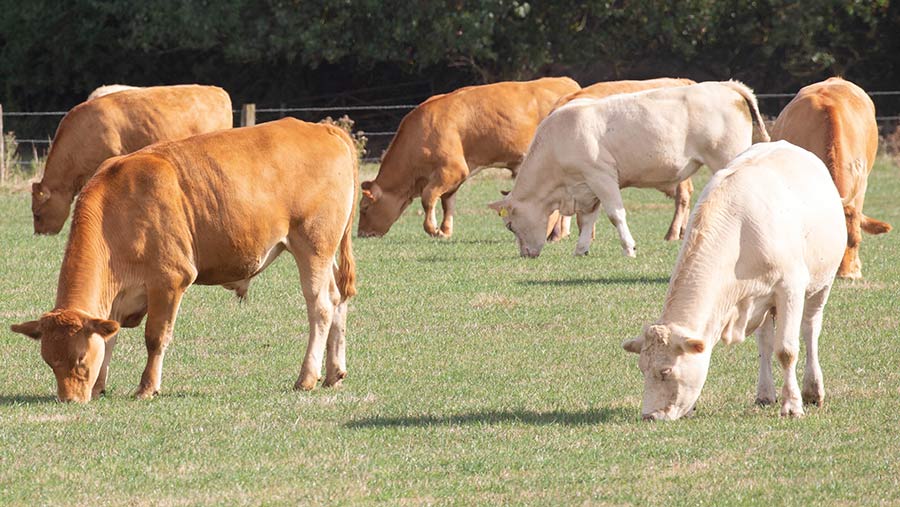Beef supply key as factories target 420p/kg deadweight
 © Tim Scrivener
© Tim Scrivener Cattle supplies may be too tight to allow base price cuts to reach the 420p/kg-mark processors have targeted later this summer, Farmers Weekly has learned.
Plans to gouge 25p/kg off the beef price may come unstuck because of the heatwave, as efforts turn from drawing cattle to haymaking and early combining, say auctioneers.
This could limit the impact of retailer efforts to force the beef price down to ensure value for shoppers.
Some consumers are buying less food than a year ago and facing food price inflation of almost 10%, according to latest national figures.
See also: Calls for £5/kg beef price grow as 2022 costs hit
Domestic beef supply is expected to increase in the second half of 2022, amounting to a 1% year-on-year increase overall, AHDB has predicted.
Cattle market fundamentals mean supply looks to remain tight, with remarkable parity between UK, Irish and the EU average reported prices, say analysts.
British deadweight base prices are about 445-450p/kg for standard commercial cattle, finishers report. However, bids of 5-10p/kg over base price are being reported for larger loads.
Feed costs pressure margins
An early harvest and dry weather may help support liveweight and deadweight beef prices by keeping a lid on supply, said Giles Drew, principal auctioneer, Northallerton Auction Mart.
Mr Drew said lots of work haymaking, combining crops a week or two earlier than normal, and a bit of Christmas trade starting in September help buoy trade through the summer.
“Combining will soon be the priority over drawing cattle, and that could help support trade,” he said. “The very early Christmas trade for topsides and joints usually starts to be seen in September.
“Forequarter meat is still selling very well, for burgers and suchlike, but we are hearing that steak meat is a bit slower.”
He acknowledged the pressure UK shoppers were under, but said that, with the cost of feed, the beef price needed to be maintained.
“Depending on diet and system, some feed costs are knocking on £4 a day, and are at £3.50 for large cattle.”
The live ring had been buoyant for 12 months or more, and at Northallerton 12-15 buyers were competing for about 250 cattle a week, added Mr Drew.
Recent prices had been at 315-325p/kg for the best butchers’ heifers, with plenty of strong cattle at about 290p/kg and strong steers and heifers grossing £2,000 and more.
Black-and-white bulls had made 200-220p/kg, with the very plainest still attracting bids worth 175-185p/kg. Continental-cross bulls had made 230-250p/kg and best suckler-bred bulls had regularly made 270-290p/kg.
Waiting game
A waiting game may result if deadweight prices see further pressure during harvest, said Stuart Vile of Meadow Quality.
Mr Vile said higher haulage costs were limiting imports and supplies of beef were tight around the world, although a US drought meant slaughter rates were up.
But he said he was at a loss to guess how the trade would pan out, with so many question marks over how the British public would react to rising living costs.
One large chain restaurant had taken lamb off its menu due to cost, and this might happen to some beef cuts, he added.
“A big question remains around how consumers will react; will they stay at home and save money?
“And can processors keep cutting out 5p/kg when farmers have bought dear cattle. It will get to the point when they might wait to sell for the Christmas trade.
“September is typically a time for a lot of Polish beef to come over, but it’s going to have a higher cost, both getting to Ireland and then getting to the UK.”
He noted a 30p/kg range among the strongest cull cow deadweight prices, which depended on whether the carcass was for an export or a retail order, with some export markets seeing the best of the trade.
Store trade
Yarding cattle prices have met a little resistance in recent weeks but remain as strong as last year. This is despite the trade being some 40p/kg up on the year.
Costs have continued to rein in store values and remain very similar to 2021 prices. Quality Meat Scotland’s broad-brush figure for 12-18-month-old store steers is bang on last year’s trade, at £950 a head.
Cattle above the 500kg-mark are still keenly sought after. More cattle may be brought forward early as grass becomes scarce.
Researchers at Teagasc said Irish farmers who buy stores for more than 255p/kg liveweight will need a beef price of more than £5/kg to cover all costs.
The numbers
8.6%
Latest official inflation figure for food and catering for May – a year ago, it was -0.4% (Office for National Statistics)
15%
Potential food price inflation later in the year as forecast by the Institute of Grocery Distribution
43%
Percentage of adults surveyed who bought less food in May, compared with 8% in September 2021 (Institute of Grocery Distribution)
